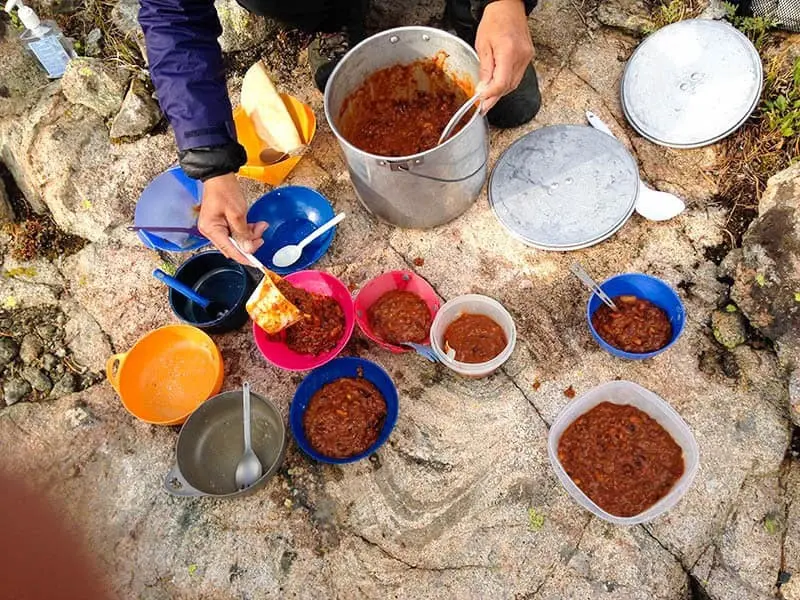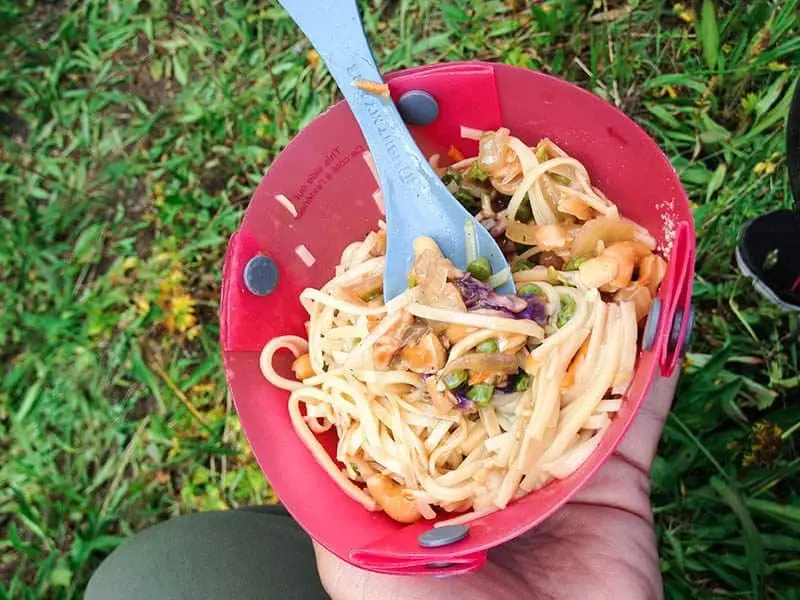This post contains affiliate links for products we love. Fusion Craftiness earns a small commission on these links at no cost to you.
Backcountry gourmet moves beyond GORP and hotdogs. The cuisine is varied, lightweight and easy to assemble. Some is cooked, some not. Nutrition and calories are important as the body needs fuel to hike and repair sore muscles and also to keep warm. 
Background
Yep, I do crazy things! Exploring the backcountry is an exciting way to experience natures beauty and power.
This can be accomplished through backpacking, canoeing, kayaking, off roading in a 4 wheel drive vehicle, horseback riding and perhaps even mountain biking. Leave a comment if I missed some other means of transportation. The benefits to this are exploring the raw beauty of nature without the noise and visual pollution of natural sights, closer to civilization such as city and state parks. You also will get some great exercise and in some cases will need to prepare physically before going such as with backpacking.
I have only backpacked but my daughter has done both backpacking and kayaking. She and her Girl Scout buddies kayaked up Harrimans Fjord in Alaska, lucky girl! Someday I would like to try something like that. Backcountry adventures can be quite dangerous though, even if you know what you are doing and have plenty of experience. For that reason I like to go with groups of people and so far have mostly done Sierra Club Trips. I love their trips because of the experience of their leaders. Also their cooking repertoire usually leans on the gourmet side, the satellite phone they carry makes me feel safer and they are wilderness first responders. They also are chosen by the club because of their ability to make sound decisions.
In a nutshell, going into the backcountry requires a lot of specialized equipment and specialized food. The food is very important due to the amount of energy you will burn carrying yourself, and your pack up over mountains, and also to stay warm. Typically with backpacking you will burn between 3,000-6,000 calories per day. Nutrition is very important. You need carbs to stay warm and for energy and you will need quality protein for muscle repair. Fats round off the macronutrients.
Backcountry food should have these three macronutrients, carb/protein/fat, probably in a ratio of 50/35/15. This is a general guideline when preparing your food systems and recipes. In normal diets the carb and protein ratios are reversed but the amount of carbs is increased for backpacking due to energy needs and staying warm. Do not neglect the protein and fat however, you need these too, but in a lower ratio. It’s important to aim for at least 3,000 calories per day for backpackers.

Water
A quick blurb about water is necessary when hashing out the details of backcountry cooking. It is very important to properly treat the water you drink as well as the water you cook with and wash dishes with. You have a few options to choose from.
Lightest Option
The chlorine dioxide tablets- Neutralizes the main types of bugs, Giardia in 30 minutes and Cryptosporidium in 4 hours. If you are on the move, use two water bottles, one that is already treated and one for treating on the go. Some people like to add water flavor enhancers to cover up the chlorine taste. You can also vent the water after the allotted treatment time.
Fastest Option
Ultraviolet light purifier- SteriPEN bombards the water with UV light neutralizing bacteria, protozoa and viruses. It requires batteries so pack extra and maybe some chlorine tablets as a backup. No bad aftertaste.
Another Fast Option
Water filters work great. They take up a little space in your pack compared to chlorine tablets and weigh more but it is a great option for those that really don’t like the chlorine taste in their water. Filters out all but viruses.
Alternative Option or Backup
Heating the water kills bacteria and parasites. This takes fuel though so should not be your main water treatment method. Fuel takes up space in your pack and is heavy. If your other water treatment system fails then this is a good backup. Also, if you are cooking soup for example, you can use untreated water and the cooking process will kill the undesirables.
For more information on backcountry water purification, the USDA has a handy PDF document available here.

Methods
There are three methods I have used successfully when preparing food. Pre-packaged, dehydrated meals in a pouch, food systems and meals requiring a recipe. A combination of all three work really well on the same trip. In addition to everything mentioned above, variety and visually exciting food is key to maintaining your appetite. Yep, you actually can lose your appetite while backpacking. The causes include high altitude, lack of variety and un-appealing food. The altitude gets me everytime. Using the three methods mentioned above helps with variety.
Pre-Packaged, dehydrated meals in a pouch
My daughter and I love shopping for pouch meals. We usually go to REI for most of our camping needs and they have a decent collection. You can also shop on the internet for some great options.
Don’t forget your grocery store! There are wonderful, much cheaper options there too. The grocery store is the place to go for food systems but they have dehydrated, pouch meals too. Think dried soup pouches. I love the Knorr variety but Lipton and Bear Creek also have some great options. Hot soup is a great appetizer/warm your body quick after a day of hiking, kind of meal. When hiking with the Sierra Club, we have hot soup every night before dinner. The salt helps replenish the electrolytes, it re-hydrates you and it warms you instantly. Don’t overlook this easy, cheap and very available resource at your local market.
The main benefits to this type of meal prep are that it’s easy, uses relatively little water and you get the variety you need to maintain your appetite.
There are two cons that I have experienced. Price and gas. Yep, gas. Nobody wants to talk about gas. Gas happens.
Food Systems
This method is basically packing some durable, nutritious items that coordinate loosely with other items. For example:
Pita bread + peanut butter = an easy lunch
Pita bread + jelly = an easy breakfast
Pita bread + tuna pouch + mayo packet + relish packet + salt & pepper = easy dinner
So in this scenario you would pack a bunch of pitas, small jar of PB, jelly packets, tuna pouches, condiment packets.
Notes about food systems:
Dehydrated foods really cut the weight down. Note cooking times and write on your packages if you are re-packaging your items into baggies (original packaging can be quite heavy). You usually need to rehydrate your dehydrated stuff except for maybe soups, they rehydrate in the pot. Variety is key!
Breakfast Food System: On the trail, cooking times differ, check package.
Add 1 from each category to make your delicious breakfast.
Category 1
Bulgar wheat, Cream of Wheat, Farina, Granola, Grits, Quick Oats
Category 2
Brown sugar, Butter Buds, Cinnamon, Cloves,Nutmeg, Dehydrated milk
Category 3
Dehydrated fruit, Coconut, Nuts, Seeds
Lunch Food System: On the trail, assemble, no cooking required, rehydrate hummus and bean mix first.
Category 1
Bagels, English Muffins, Pita, Tortillas, Triscuits, Flat bread
Category 2
Bean mix (rehydrated), Cheddar cheese block, Honey, Dehydrated hummus mix, Jelly packets, Peanut butter, Summer sausage, Salmon pouch, Tuna pouch, Chicken pouch
Category 3
Salt & pepper, Catsup packets, Mayo Packets, Mustard, Olive oil, Red pepper flakes
Dinner Food System: On the trail, bring 3 cups of water to a boil, add one equivalent from each category, simmer 5 more minutes.
Category 1 Dehydrated vegetables and legumes (Use 1/2 cup per serving)
Black beans, Broccoli, Butter beans, Corn, Green beans, Kidney beans, Lima beans, Onions, Peas, Pinto beans, Carrots
Category 2 Dehydrated or cured meats (Use 1/4 cup per serving)
Chicken or salmon in a pouch, Ground beef, Summer sausage, Tuna in a pouch, TVP (textured vegetable protein), Turkey
Category 3 Carbohydrates (Use 1/2-1 cup per serving)
Bulgur, Couscous, Grits, Hash browns (dried), Noodles, Potato flakes, Instant rice
Category 4 Spices
Salt, Pepper, Bouillon cubes or powder, Curry powder, Garlic powder, Italian seasoning, Lemon pepper, Onion Powder, Red pepper flakes, Sage, Salsa (dehydrated or in packets), Smoked paprika, Soy sauce, Hot sauce


Resources
(These are affiliate links)
Books I recommend:
Lipsmackin’ Backpackin’, 2nd by Christine and Tim Conners
Recipes for Adventure: Healthy, Hearty and Homemade Backpacking Recipes by Chef Glenn McAlister
Ultralight Backpackin’ Tips: 153 Amazing & Inexpensive Tips For Extremely Lightweight Camping by Mike Clelland
Gear I recommend:
MSR PocketRocket Stove
G4Free Outdoor Camping pan Hiking Cookware Backpacking Cooking Picnic Bowl Pot Pan Set 4 Piece Camping Cookware Mess Kit
You don’t have to pack all of the pieces but it gets you everything you need.
My favorite hack:
The bottom of a bleach bottle cut out for a bowl/plate, it’s durable and extremely light weight and free. I also use a bleach bottle bottom cut out from a quart bottle to use as a ‘bath tub’. No need to spend big bucks on super light weight (super expensive) bowl.
Enjoy and be safe! Leave a comment for your ideas and recommendations so we can all benefit.
Bon Appetit and happy trails y’all!
